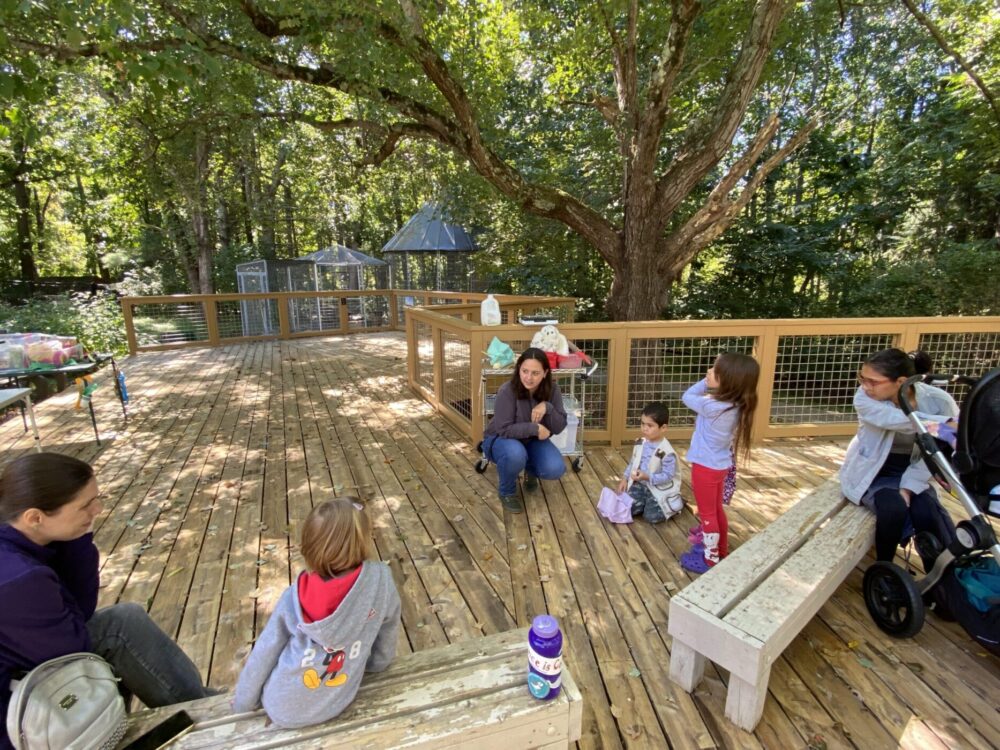Welcome to the Raptor Deck
Meadowside Nature Center (MNC) is home to permanently injured, non-releasable birds of prey, also known as raptors. Located behind the nature center, our accessible Raptor Deck allows you to view the magnificent birds. Stop by to visit* when the nature center is open, during our normal business hours.
*The Raptor Deck is open on select Wednesdays and Saturdays. Please register for a free raptor chat at Active Montgomery.
About Birds of Prey
Birds of prey are predators at the top of their food chain and have been admired by humans for years. They can be broken into several groups like diurnal (active during the day) birds and nocturnal (active at night) birds. Some common families or groups of raptors are hawks, falcons, owls, and eagles.
All raptors have three defining features:
- Keen eyesight – Diurnal raptors have full color vision. Nocturnal raptors such as owls have an added advantage of night vision.
- Sharp talons – Birds of prey have powerful leg and toe muscles that end with sharp talons. Their feet are perfectly designed to catch, hold, and carry prey. Most birds of prey have three toes pointing forward and one pointing backward that creates a powerful grip.
- Hooked beak – The raptors’ beak sets them apart from other birds. All raptors have the same beak design: curved at the tip with sharp cutting edges to rip and tear apart their prey (Source: Bureau of Land Management).
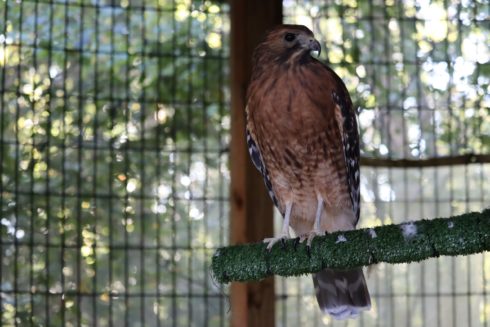
The raptors once lived in the wild, and each raptor received injuries that needed medical attention. After their injuries healed, they were considered non-releasable and have since found their way to a new home at Meadowside Nature Center. Now, some of the birds are on exhibit, in homes called mews, and are ambassadors of their species as well as trained for their own welfare.
Read about each bird and its journey to Meadowside Nature Center below.
Meet The Resident Raptors
There are currently five raptors that call Meadowside Nature Center home. Click through the questions below to learn more about each of the birds of prey.
Each of the raptors receives excellent human care which includes an active enrichment and training program. Enrichment and training stimulate their minds and expand their activity level to replicate a natural life. Our qualified naturalists focus on raptor cognitive behavior, food, social, and sensory activities.
Red-Tailed Hawk
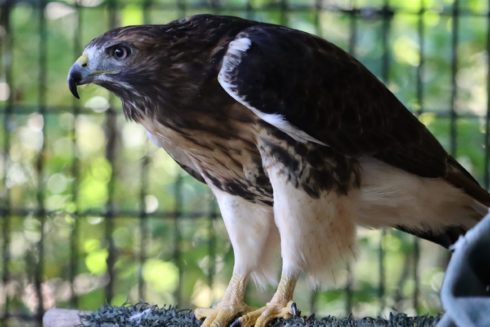
- Her favorite food is a rat.
- Scarlet is inquisitive and for enrichment, she seems to enjoy uncovering her food from under new objects like different colored cups. This enrichment mimics how she would search for and locate prey that are hiding under leaves or other natural objects.
- It takes about two years for the red-tailed hawk to grow into their adult feathers and to earn their iconic brick red tail.
Red-tailed hawks fall into a raptor group called buteo. Birds in this group have broad wings and short tails and are often soaring overhead in open areas. Red-tailed hawks are commonly found perched along open road or highways looking for rodents that are attracted to discarded human food waste.
Other birds in this group that live in Maryland are the rough-legged hawk, broad-wing hawk, and the red-shouldered hawk.
Red-tailed hawks prefer wide-open spaces and are not likely to visit a bird feeder. These birds are best viewed soaring over fields or hunting along the forest edge. They mate for life and can be found year-round in Maryland.
Searching for a red-tailed hawk may be challenging, but recognizing their call is much easier. Did you know that there is a good chance that if you have seen a Hollywood Western movie, you are already familiar with the call of a red-tailed hawk? Their call is often dubbed over other bird calls, even if the bird is not the same species. Often the American bald eagle call (listen to Orion’s call above), is thought to be weaker and less impressive than other bird sounds and is often dubbed over with the red-tailed hawk.
Sound clip coming soon!
Scarlet was found with an injured wing in Frederick, Maryland and has been living at MNC since 2011. After her wing healed, she could partially fly, but not well enough to hunt for herself.
Injuries to red-tailed hawks are common along highways and other open roads. Since over 90% of their diet is made up of rodents, red-tailed hawks are often seen perched on road signs looking for prey. As people drive down these roads, it is not uncommon to see food litter and trash. Leftover food attracts rodents, rodents attract hawks, and cars often collide with hawks while they hunt.
One way you can help support the red-tailed hawks and other birds that perch along the highway is to stash your trash. Don’t throw food waste out your window; instead, store the food scraps with the other waste items. You are going to eventually throw out the paper takeout bag and cup and might as well save food too.
What should I do if I find injured wildlife? Visit the Maryland Department of Natural Resources to locate a wildlife rehabilitator.
Red-Shouldered Hawk
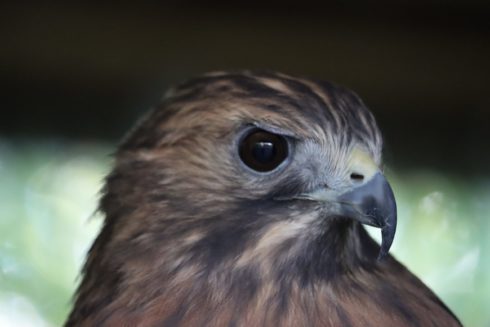
- Her favorite food is a mouse.
- In the wild, Summer would live in a wooded habitat near rivers and swamps that provide her with food sources and plenty of places to hide. Like Scarlet (the red-tailed hawk), she is inquisitive, and for enrichment, her food is occasionally hidden under an item, such as a cup, or tucked inside a paper tube. In the wild she would normally eat prey items that are well hidden. By hiding her food in a paper tube, she must tear the tube apart to find her treat like how she would hunt in the wild.
- Red-shouldered hawks have a reputation for being of the most vocal birds in North America.
The red-shouldered hawk falls in the buteo group. However, members can be found living in typical accipiter habitat such as wooded areas. Other birds in the accipiter group include the cooper’s hawk, sharp-shinned hawk, and Northern goshawk.
To tell the two groups apart, the accipiter hawks are usually slim with short, rounded wings. They often hide in the woods as they search for prey. Their short wings and long tails make them very agile and they can easily fly through a forest, weaving around trees and branches. Buteos, as mentioned above, have broad wings and short tails and are often seen soaring overhead in open areas. The red-shouldered hawks seem to have a mixture of these characteristics, which gives them the ability to thrive in both buteo and accipiter habitats.
Red-shouldered hawks can be found in Maryland year-round, but they are more common in Florida and California. There are at least two red-shouldered hawks that live nearby and they can often be seen hanging around the nature center. Remember that these birds are known to be vocal and you will probably hear them before you see them.
Summer arrived at Meadowside Nature Center in the summer of 2015, which is how she got her name! She was found wandering around someone’s backyard, seemingly disoriented. While we don’t know exactly what kind of original injury Summer sustained, she has poor vision in her left eye.
Red-shouldered hawks can grow accustomed to people, allowing them to get close. One way to support these hawks is to admire them from afar. If humans get too close to the hawks, they might accidentally scare away their food. It is important to keep wildlife wild and not encourage close human interaction.
What should I do if I find injured wildlife? Visit the Maryland Department of Natural Resources to locate a wildlife rehabilitator.
Great Horned Owl
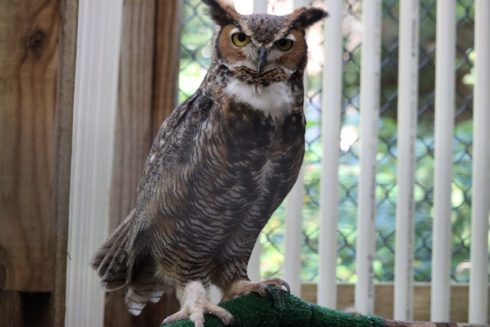
- His favorite food is rat.
- When clenched, a great horned owl’s strong talons require a force of 28 pounds to open (Source: All About Birds! For enrichment, Calusa’s food is often hidden in items where he has to use his talons to squeeze or tear his way through to get to his food.
- Great horned owl feathers have frayed edges and they have feathers on their legs and talons. The frayed edges allow the owl to fly silently through the air and surprise their prey.
Owls in general have many facial features that help them locate prey. For example, they can turn their head 270 degrees to follow a sound, have asymmetrical ears, and have a facial disc that funnels sound to the ear openings. On the face of the great horned owl, the “horns” are feather tufts that break up the round shape of the face and help it camouflage with the brown bark of trees.
Owl pairs are monogamous, meaning they will have the same mate for life. Females are larger in size, but males have a deeper call. When a pair is calling together, males and females can be determined by the pitch of the call. If an owl is defending a nest or feels threatened, it will clack its beak, hiss, and make deep grunting sounds giving the intruder a warning that they better move away (Source: All About Birds).
Click to hear a sound clip of Calusa hooting during a winter storm.
Calusa came to Meadowside in July of 2019. His original rehabilitators believe he may have fallen out of his nest as an owlet, and as a result, suffered a trauma that caused a cataract to form in his left eye. During his rehabilitation as a baby, he imprinted on his human caregivers. Once an owl imprints on a human, it can potentially experience unnatural relationships with both humans and other great-horned owls, leaving it non-releasable. Reversing this process is almost impossible and Calusa will identify with humans rather than other great horned owls.
What should you do if you find a baby bird? According to the U.S. Fish and Wildlife Services, the best thing to do is put the baby bird back in the nest, if you can locate it, and do so as soon as you can. If you find several young birds and the nest has been destroyed, search for a local, licensed wildlife rehabilitation facility near you. Do not try to feed the birds or give them water. Baby birds can be transported in a clean box with a lid. If you find a large, injured bird, call the wildlife rehabilitation facility and ask for advice on what to do next.
What should I do if I find injured wildlife? Visit the Maryland Department of Natural Resources to locate a wildlife rehabilitator.
Barred Owl

- His favorite food is chicken.
- Sterling prefers to hunt for food just after sunset. For his enrichment, his food item is often hidden in a paper tube or box and left overnight for him to feed when it feels natural for him.
- Barred owls, named for the brown “bars” of feathers on their back and tail, do not migrate and prefer to live near a water source.
Barred owls have an iconic call that to some, sounds like the owl is saying “Who cooks for you?” “Who cooks for you all?” During courtship, owl pairs will often use this call mixed with other clacks and deep sounds and some people think it sounds like a group of monkeys calling in the forest!
Sound clip coming soon!
Barred owls eat many kinds of small animals, including mammals, amphibians, reptiles, and invertebrates. They hunt by sitting and waiting on a perch while scanning all around for prey with their sharp eyes and sensitive ears. Most of their hunting occurs right after sunset and during the night. Barred owls may temporarily store their prey in a nest, in the crook of a branch, or at the top of a snag (Source: All About Birds). Sterling has been known to leave his food item overnight and will pick at it early in the morning or whenever he feels like a snack.
Sterling came to Meadowside Nature Center in 2013. He flew into a delivery truck and got caught between the driver’s door and side mirror. The driver took him to a bird of prey rehabilitation center where he was treated for a broken right wing that did not heal quite properly, making him non-releasable.
Barred owls live in forests and tend to prefer older forests that have dead trees for nesting. However, old forests are usually used for logging and clearcutting which removes the owl’s habitat. For this reason, the barred owl is often used as an indicator species for managing old forests. An indicator species is used by biologists to determine the health status of an environment. If barred owls are found in a forest, it can mean that the forest is well established, long-lived, and has a healthy food chain.
If an animal is losing its habitat, an artificial habitat could be created to help provide that animal with more options. Barred owls will often live in nest boxes in or near mature forests. Consider putting up a nest box to attract a breeding pair. Make sure the nest box is up well before breeding season (between March and August) or you might have to wait until next year for a pair to arrive. To learn more about nest boxes, visit All About Birds.
What should I do if I find injured wildlife? Visit the Maryland Department of Natural Resources to locate a wildlife rehabilitator.
Black Vulture

- Gillis’s favorite food is venison. She receives it as a small part of her diet every day.
- Vultures help clean up the environment by eating dead animals before they rot and cause disease. This is one of the many important roles these scavenging birds fulfill by “cleaning up” dead animals from our forests, fields, and roadsides.
- Vulture feces is free of bacteria, viruses, and fungi due to their incredibly strong stomach acids.
In the United States, vultures are known colloquially as “buzzards” although this term is technically not correct. The word “buzzard” correctly refers to several species of hawks that are native to Europe.
Many vulture species are “gregarious”, meaning they are quite social and prefer to live in large groups. Individuals often fly together in flocks or “kettles” when migrating and searching for food. Outside of the breeding season, turkey vultures and black vultures often roost together, sometimes by the hundreds
Gillis came to Meadowside in February of 2023. Her rehabilitators think she hatched in a barn without her parents. She was discovered a few days later, hungry and dehydrated by the owner of the barn.
During her rehabilitation as a chick, she unfortunately imprinted on humans. Once imprinting occurs, a bird can develop unnatural behaviors and relationships with both humans and other birds of its species, leaving it non-releasable. Reversing this process is almost impossible and Gillis will always identify with humans rather than other vultures.
Imprinting is a form of learning in which an animal gains its sense of species identification. Birds do not automatically know what they are when they hatch – they visually imprint on their parents during a critical period of development. After imprinting, they will identify with that species for life. (Source: https://www.wildlifecenter.org)
It is best if you don’t handle a baby bird unless absolutely necessary. Do not try to feed baby birds or give them water. According to the U.S. Fish and Wildlife Services, if you find a baby bird, the best thing to do is put the baby bird back in the nest as soon as you can. If the baby bird is injured, or the nest has been destroyed, search for a local, licensed wildlife rehabilitation facility near you. Baby birds can be transported in a clean box with a lid.
